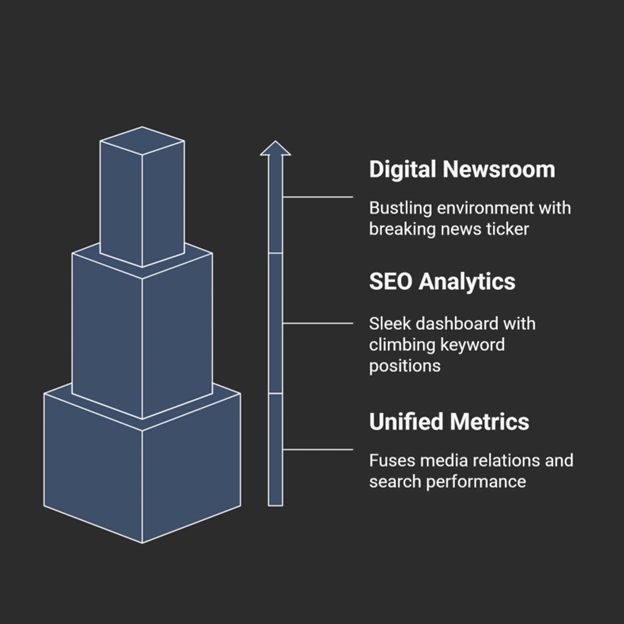Why PR-Led Link Building Matters in 2025

PR-led link building turns earned media coverage into authoritative backlinks that boost organic rankings.
In 2025, Root Digital found that 54 % of PR teams now share hard SEO KPIs with search colleagues—a signal that newsrooms and SERPs finally share the same scoreboard.
Why care? One do-follow link in an editorial story can deliver ranking equity no paid ad can match. Google counts every citation as a third-party vote of trust, and that equity multiplies each time the article is syndicated or quoted.
Yet journalists’ inboxes overflow with AI-generated pitches. Publications crave fresh data and human insight—the currency seasoned PR pros trade best.
This guide outlines seven practical steps to convert today’s headlines into compounding search equity. Blend classic media instincts with modern SEO tactics, and your coverage will keep paying dividends long after the news cycle ends.
Step 1 – Align PR goals with a link-building strategy
Start with shared, numeric SEO goals. Decide whether you’re chasing organic sessions, top-10 rankings for “fintech payroll software,” or a 20-link bump in referring domains this quarter—then tie those metrics to existing PR KPIs so every team rows in sync.
Define an authoritative backlink for your niche: a do-follow citation on a DR60+ page that already attracts 500+ monthly visitors. Relevance still outweighs raw authority, so links on pages closely aligned with your core keywords send the strongest signals.
Run a 15-minute competitive audit in Ahrefs or Moz: export six months of new referring domains for two rivals, filter for DR60+, and flag outlets covering your sector. Those URLs become your top-20 “dream list.”
Audit capacity next. Effective outreach demands daily follow-ups, anchor-text troubleshooting, and clean CRM data. If your team can’t send 30 tailored emails a week, enlist a link building service partner—an outreach-focused agency like Outreach Labs—who works under your brand umbrella while you steer the story.
Quick checkpoint—confirm all three before advancing:
- SEO KPIs linked to PR objectives
- Target-outlet list vetted and ranked
- Enough hands (or partners) to execute Pause and fill any gap; every later tactic assumes this groundwork is solid.
Step 2 – Build link-worthy content assets & angles
Organic backlinks scale when you offer a link magnet—an original asset journalists cite on autopilot.
- Harvest proprietary data. Run a 1,000-respondent survey or surface anonymized product stats that competitors can’t match. One headline figure—“42 % of Gen Z shoppers trust TikTok reviews over Google”—can anchor dozens of stories.
- Package insight for journalists. Host the full dataset on an open, indexable URL and embed a share-ready visual (SVG chart under 100 KB, alt-tagged with your primary keyword). Search engines crawl it; reporters lift it.
- Layer narrative angles. Pair the numbers with a founder anecdote, contrarian quote, or regional breakout so editors have multiple hooks.
- Future-proof originality. Before launch, Google the key stat. If it doesn’t appear in the first 20 results, you own the whitespace. Duplicate data dies fast in AI-generated feeds.
Quick green-light checklist:
- Exclusive, verifiable data
- Graphic or interactive that makes the stat skimmable
- Pull-quote or hero figure that pops
- Landing page loads in < 2 s and stays ungated. Hit all four and you’ve built a backlink flywheel that spins long after the press release fades.
Step 3 – Target the right publications and journalists
Securing coverage starts with finding the right newsroom match—the outlet most likely to grant a high-value backlink.
Lead with relevance, not reach. Google assigns more authority to sites that routinely cover your client’s niche, rewarding topical alignment over sheer Domain Rating (DR).
Build a Publication Outreach Matrix and score each prospect 1–5 on four factors:
- Beat Fit – Do the journalist’s last five stories map to your core keywords?
- Authority – DR60+ for national tech sites, DR40+ for niche verticals.
- Traffic Health – 1,000+ organic visits per month; anything less is a ghost town.
- Link Policy – Editorial do-follow allowed in body copy.
Sort by total; your top 20 become the “A-list.”
Layer in competitor intelligence: any outlet that is linked to a rival’s research within the last 90 days should receive your pitch within 48 hours of asset launch.
Finally, tier effort:
- Tier 1 – Global or flagship industry bibles: high lift, massive halo.
- Tier 2 – Well-trafficked niche sites, regional business journals, influencer newsletters: sweet-spot equity.
- Tier 3 – Trade associations and moderated forums: lower traffic, hyper relevance.
Engage like a human. Follow reporters on X, comment on recent pieces, and share unrelated tips weekly; these micro-touches prime the inbox before your pitch arrives.
Step 4 – Craft personalized pitches & press releases that earn links
A personalized outreach email is the make-or-break moment when a journalist decides to grant you a backlink.
Keep the message under 120 words and lead with the newsworthy number. Example subject: “42 % of Gen Z trusts TikTok reviews—new data.” Use a single-sentence hook that ties the stat to the reporter’s beat, then deliver two compact paragraphs:
- Context (≈45 words): Explain why the insight matters right now—and to their readers.
- Offer (≈60 words): Link to the full dataset, quote-ready expert, and a fresh angle that’s still off-wire.
Close with one friction-free CTA: “Let me know if you’d like crosstabs or a quick call.” Reference the journalist’s recent work to show relevance and depth.
Follow up once—three days later—with a new angle, not a nudge. Additional pings look desperate and may trigger spam filters.
Press-release wires build awareness but rarely pass equity because replicas are no-follow. Use them for reach, then rely on targeted emails for do-follow wins.
Place your link inside descriptive text (e.g., 2025 Gen Z Commerce Report) rather than exact-match keywords; semantic relevance and editorial tone carry more ranking weight.
Step 5 – Leverage HARO & reactive opportunities for quick wins
Expert-source platforms such as HARO, Qwoted, and Help a B2B Writer can deliver backlinks in days, not quarters. Success depends on speed and relevance.
HARO playbook
- Triage fast. Scan the three daily digests within 15 minutes. Answer any high-fit query within 90 minutes; acceptance rates fall below 5 % after hour three.
- Serve the quote, not the ad. Lead with authority credentials (title + years in field), share one compelling data point, add a quotable sentence, and link to the supporting study.
- One-and-done. HARO etiquette discourages follow-ups—submit and move on.
Reactive news-jacking
- Set real-time alerts for priority keywords and competitor names.
- When a trigger hits—regulation, funding round, outage—draft a 100-word expert take and send it to Tier-1 journalists within 30 minutes.
- Provide exclusive data or a contrarian angle to elevate the story.
Quality guardrails
- Insight first, brand second.
- Confirm each outlet’s linking policy before sharing proprietary charts.
- Log every success to refine topics, timing, and spokesperson rotation.
A handful of timely HARO hits or reactive quotes can keep backlink momentum alive while larger campaigns take shape.
Step 6 – Secure strategic guest posts & niche edits
Guest posts and contextual link insertions diversify your backlink profile—if each placement passes strict quality gates.
Guest posts (thought leadership)
- Target sites with DR60+ and ≥ 5 k organic sessions per month.
- Maintain a 3:1 ratio of staff to contributor articles; anything lower signals a potential link farm.
- Pitch a data-backed POV that fills a known content gap and reference your study once, in context.
Contextual link insertions (ethical niche edits)
- Find evergreen guides already ranking top 20 for your keyword.
- Supply a fresh stat or mini-case study that genuinely improves the copy.
- Use natural anchor text—brand name or resource title—to avoid Google’s anchor-mismatch demotion filter.
Governance & scale
- Non-negotiable floor: DR50, 1 k monthly traffic, zero PBN footprints.For a vetted roundup of platforms that meet these standards, review this guide to top guest-post services.
- Review every draft; the author bio must match your client’s credentials on-site and on LinkedIn.
- Log each placement with URL, DR, anchor, and live date to track indexation and traffic.
A dozen well-placed guest columns or context edits can close topical gaps that pure media outreach misses—positioning your client as a subject-matter authority across the web.
Step 7 – Track results & continuously refine
A link-performance dashboard turns raw URL counts into boardroom wins. Track four pillars every week:
- Authority – DR of new referring domains and change versus last quarter.
- Visibility – Position shifts for target keywords and incremental impressions.
- Engagement – Page views, time on page, and assisted conversions from each link.
- Revenue Proxy – Pipeline or sales influenced; tie every major link to dollars whenever possible.
Every quarter, run a retrospective. Stack tactics—HARO, guest posts, digital PR—side by side and calculate cost per high-DR link. Double down on channels under $150 per link and retire the laggards.
Executives expect speed: 67 % anticipate ROI within six months. Translate metrics into business outcomes—“This Forbes link drove 1,200 visits and $30 k in pipeline,” not “DA +4.”
Stay agile. Monitor Search Console for sudden drops that may signal a link-spam update. Be ready to disavow toxic domains, refresh stale bios, or pivot anchor strategies within days.
Measure → learn → iterate. That flywheel turns one-off wins into compounding authority no paid channel can match.
Frequently Asked Questions
What is PR-led link building? PR-led link building combines traditional media outreach with SEO goals, earning editorial backlinks that boost organic rankings while delivering brand exposure.
How long does it take to see ROI from PR-led link building? Expect meaningful results within about six months—the timeframe most executives use to judge ROI—though momentum builds faster when strategies like HARO and reactive outreach run alongside larger campaigns.
What makes a backlink authoritative? Authority comes from a do-follow link on a relevant page with strong metrics (e.g., DR60+ and 500+ monthly visitors) that align closely with your core keywords.
Conclusion – Your next 90 days
Ready to turn publicity into measurable SEO gains? Use the next 90 days to build PR-led link-building momentum:
- Launch one flagship, data-rich campaign capable of earning 15+ high-authority backlinks.
- Run two velocity plays every week—answer five HARO queries and publish one guest column in a trusted niche outlet.
- Measure, refine, repeat. Track referring domains, organic sessions, and assisted pipeline each Friday to adjust in real time.
When backlinks become a core KPI, every pitch, quote, and asset compounds—brand exposure today, search equity tomorrow.
Share
Table Of Contents
- Step 1 – Align PR goals with a link-building strategy
- Step 2 – Build link-worthy content assets & angles
- Step 3 – Target the right publications and journalists
- Step 4 – Craft personalized pitches & press releases that earn links
- Step 5 – Leverage HARO & reactive opportunities for quick wins
- Step 6 – Secure strategic guest posts & niche edits
- Step 7 – Track results & continuously refine
- Frequently Asked Questions
- Conclusion – Your next 90 days
